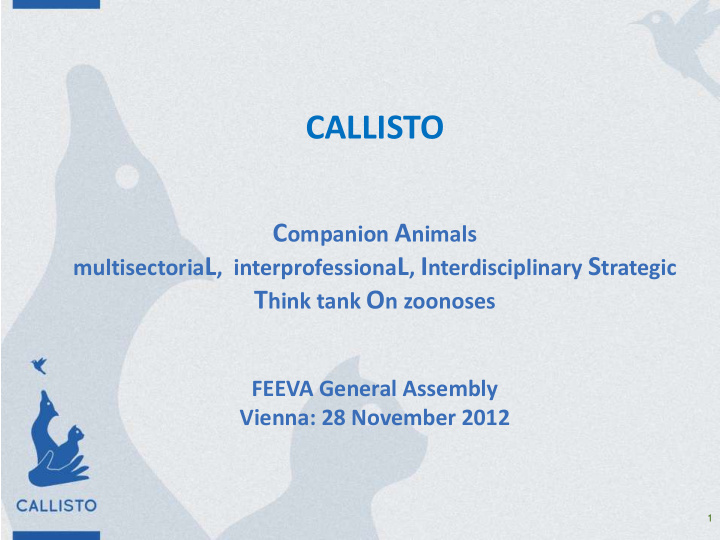



CALLISTO C ompanion A nimals multisectoria L , interprofessiona L , I nterdisciplinary S trategic T hink tank O n zoonoses FEEVA General Assembly Vienna: 28 November 2012 1
The CALLISTO project • Background • Aims and expected impact • Consortium partners • Scientific and expert input: 7 Expert Advisory Groups • Operational plan: 5 Work Packages • Deliverables 2
Background • Increasing awareness about benefits and risks associated with close interaction of companion animals with people and with food animals • Information on incidence of disease transmission from companion animals to people and to food producing animals as well as on strategies for disease prevention and control is fragmented 3
Background • The Seventh Framework Programme for Research and Technological Development (FP7) is the EU's main instrument for funding research in Europe. It runs from 2007-2013. • Dec 2006: European Parliament and Council: the maximum overall amount for Community financial participation in FP7 shall be EUR 50 521 million, distributed among different activities and actions . 4
Background Call KBBE.2011.1.3-03: July 2010 European interprofessional network addressing zoonotic diseases transmitted via companion animals July – Dec 2010 Consortium established and proposal develloped Jan 2011 Proposal submitted May 2011 Proposal selected June – Nov 2011 Drafting grant agreement Dec 2011 Agreement signed Jan 2012 Project started: kick off meeting Dec 2014 End of Project: Final report and Recommendations 5
Aims and expected impact 1. Think tank: Multidisciplinary and multisectorial interprofessional network of experts 2. To provide an overview of the current situation 3. To identify knowledge and technology gaps in the management of the most important zoonoses transmitted by companion animals 4. To propose targeted actions to prevent, reduce, eliminate health risks for humans and food animals associated with keeping companion animals 6
Aims and expected impact (2) • Adressing in a comprehensive approach the companion animals in our society and their implication in the transmisssion of pathogens affecting humans and food animals • Impact on public and animal health and welfare • Transfer of knowledge to different layers of society 7
DEFINITION OF COMPANION ANIMAL Companion animals are any domesticated, domestic-bred or wild-caught animals permanently living in a community and kept by people for company, amusement, work (e.g. support for blind or deaf people, police or military dogs) or psychological support – including dogs, cats, horses, rabbits, ferrets, guinea pigs, reptiles birds, or ornamental fish.
Consortium Partners • Federation of Veterinarians of Europe (FVE) • University of Copenhagen (UCPH) • International Association of Human-Animal Interaction Organisations (IAHAIO) • Erasmus Medical Center (EMC) • World Small Animal Veterinary Associations (WSAVA) • Federation of European Companion Animal Veterinary Associations (FECAVA) • Instituto Zooprofilattico Sperimentale dell’Abruzzo e del Molise “ G.Caporale ” (ICT) • The Hebrew University of Jerusalem (HUJI) • University of Bristol (UoB) 9
Expert Advisory Groups
Organisational: 5 Work Packages
Management Structure
Work flow
Work flow
Deliverables • EAG reports • Cross EAG preparatory reports • Cross EAG synthesis reports • CALLISTO strategy report • Current situation (2012) • Risk assessment (2013) • Proposed actions (2014) • CALLISTO website – www.callistoproject.eu • CALLISTO publications 15
Conference October 2012 • Demographic data – large gaps in accurate data on numbers, distribution and means of keeping companion animals • European diversity • Scoring criteria for the ranking of pathogens • Small animal infectious disease surveillance • Disease prevention and control – recognition that this should be incorporated into the current report • One health – and the challenges of implementing a true one health approach • The impact of current policies – how do we measure this?
Thank you!
More recommend